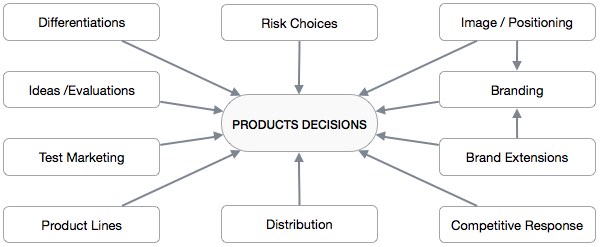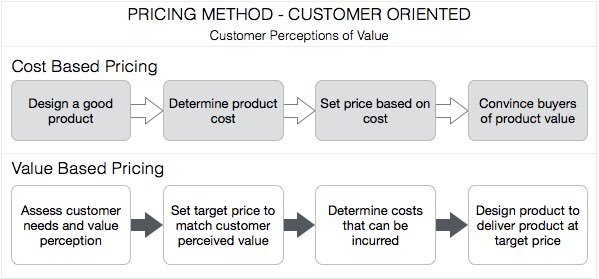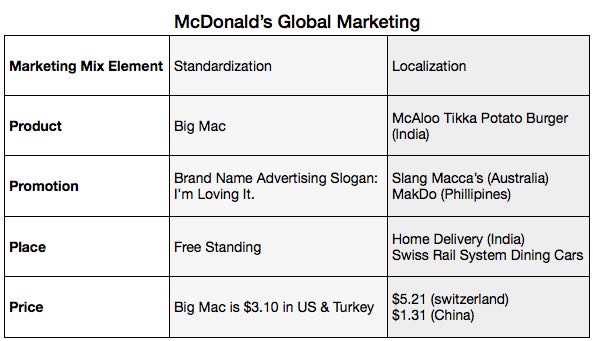
- IB Management Home
- International Trade
- General Agreements On Tariffs & Trade
- World Trade Organization
- Global Trade Major Challenges
- Modern Theories
- Global Competitiveness
- Regional Trading Blocs
- Major Trade Blocs
- Strategic Approaches
- Strategic Compulsions
- Global Portfolio Management
- Modes of Entry
- Organizational Structures
- Control Mechanisms
- Performance Issues
- Business Operations
- Production Issues
- Supply Chain Issues
- Global Marketing Mix
- Financial Aspects
- HRM Issues
- Miscellaneous
- Adverse Effects
- Conflict Management
- Negotiations
- Ethical Issues
- Useful Resources
- Quick Guide
- Useful Resources
- Discussion
Global Marketing Mix
Global Marketing combines the promotion and selling of goods and services with an increasingly interdependent and integrated global economy. It makes the companies stateless and without walls.
The 4P's of Marketing − product, price, place, and promotion − pose many challenges when applied to global marketing. We take each one of the Ps individually and try to find out the issues related with them.
Global Marketing Mix: Consumer Products
The product and service mix is one of the most important ingredients for the global marketer today. The diverse demand for products and services in the era of globalization is mind-blowing. Presence of industrialized and emerging markets, increasing purchasing power, and the growth of Internet has made the customers aware, smart, and more demanding. The result is a greater competition between firms.
Here are the important factors to consider when going global with a product or service.

The global consumer makes purchasing decisions to get the best quality products at the most affordable price. They have information available in abundance, thanks to the Internet. Therefore, innovation takes center-stage to gain adequate attention from potential consumers.
A global marketer must be flexible enough to modify the attributes of its products in order to adapt to the legal, economic, political, technological or climatic needs of a local market. Overall, global marketing requires the firms to have available and specific processes for product adaptation for success in new markets.
Culture can differentiate a standardized product from an adapted one. Making cultural changes in product attributes is like introducing a new product in your home country. The product should meet the needs, tastes, and patterns that are permitted by the market culture.
Lastly, it is essential to understand that a product or service is not just one "thing." It should be seen as a part of the whole marketing mix so that a great synergy can be built among different strategies and actions.
Global Marketing Mix: Price
Pricing is a crucial part of the marketing mix for international firms. Pricing techniques play a critical role when a company wants to penetrate into a market and expand its operations.
Drivers in Foreign Market Pricing
The most important factors that decide the prices are labelled the 4 Cs −
- Company (costs, company goals)
- Customers (price sensitivity, segments, consumer preferences)
- Competition (market structure and intensity of competition)
- Channels (of distribution)
International Pricing Challenges
Global firms face the following challenges while pricing their products and services to suit the requirements of international market −
Export Price Escalation − Exporting includes more steps and higher risks than domestic sale. To make up for shipping, insurance and tariffs, and foreign retail prices, the export price may be much higher than domestic country. It is important to know whether external customers are willing to pay an additional price for the products/services and whether the pricing will be competitive in that market. If both answers are negative, then there are two approaches. One is to find a way to decrease the export price, and the second is to position the product as an exclusive or premium brand.
Inflation − Intense and uncontrolled inflation can be a huge obstacle for MNCs. If inflation rates are rampant, setting prices and controlling costs require full dedication of marketing and financial divisions. Some alternatives to counter inflation include changing the components of products or their packaging, procuring raw materials from low-cost suppliers and shortening credit terms, etc.
Currency Movements − Exchange rates being unstable, setting a price strategy that can get rid of fluctuations gets difficult. Key considerations include what proportion of exchange rate gain or loss should be transferred to customers (the pass-through issue), and finding which currency price quotes are given in.
Transfer Pricing − Transfer prices are the charges for transactions that involve trade of raw materials, components, finished products, or services. Transfer pricing include stakeholders, such as the company, local managers, host governments, domestic governments, and joint-venture partners. Tax regimes, local conditions, imperfections, joint venture partners and the morale of managers affect transfer pricing.
Anti-dumping Regulations − Dumping occurs when imports are sold at an unfair and very low price. Recently countries have adopted anti-dumping laws to protect their local industries. Anti-dumping laws should be considered when deciding global prices.
Price Coordination − Price coordination is the relationship between prices charged in different countries. It is an important consideration while deciding the global pricing model. Price coordination includes the following factors − Nature of customers, Product differentiation amount, Nature of distribution channels, Competition type, Market Integration, Internal organizational characteristics, and Government regulations.
Countertrade − Countertrades are unconventional trade-financing transactions including non-cash compensation. A monetary valuation can however be used in countertrade for accounting purposes. In dealings between sovereign states, the term bilateral trade is generally used. Examples include clearing arrangements, buybacks, counter purchases, switch trading, and offsets.

Global Marketing Mix: Promotion
Promotion comes into picture when a global company wants to communicate its offering to potential customers. How an organization chooses to promote its products and services can have a direct and substantial impact on its sales.
Advertising and Culture
Advertising can create a popular culture and a culture may influence the ad as well. Cultures impact in advertising is prevalent, especially in culturally-sensitive issues like religion and politics.
Cultural Effect
Procter & Gamble had problems advertising the Pert Plus shampoo in Saudi Arabia, where only veiled women can be shown in TV commercials. The company had to show the face of a veiled woman, and the hair of another from the back.
Setting a Budget
A global marketer can consider budgeting rules such as percentage of sales (creating budget as a percentage of sales revenues), competitive parity (taking competitors ad spending as a benchmark), or objective-and-task (treating promotional efforts to achieve stated objectives). Global markets use three approaches to reach allocation decisions −
In bottom-up budgeting, the units independently determine the market budget and request resources from headquarters.
In top-down budgeting, the headquarters set a total budget and split up the resources.
Decisions may also be made at a regional level and submitted to the headquarters for their approval.
Promotional Strategy
When global marketers choose a standardized approach, the same global campaign is applied throughout all countries.
Advantages − Achieving economies of scale in ad campaigns to reduce cost, maintaining a consistent brand image.
Barriers − Cultural differences resulting in negative or ineffective consumer response, advertising laws and regulations, variations in degree of marketing development.
The NIH Syndrome: A Barrier to Standardized Approach
Not Invented Here syndrome occurs when agencies or business subsidiaries reject using a standardized campaign simply because they did not invent or come up with the campaign.
Assessing Global Media Decisions
Global media decisions are a big concern for global firms. The media buying patterns vary across countries. A global marketer must find the best media channels in a market.
Ad Regulations
Foreign regulations on advertisements may be present in a specific country. Research of the laws in the country of operation is necessary before developing a campaign, to avoid legal implications and waste of time and money.
Choosing an Agency
Choosing an ad agency may prove more effective due to their understanding of the country and market they are doing business in.
Other Communication Options
Sales events, direct marketing, sponsorships, mobile marketing, product placement, viral marketing, and public relations and publicity are also applicable.
Globally Integrated Marketing Communications (GIMC)
A GIMC is a system of promotional management that coordinates global communications - horizontally (from country to country) and vertically (promotion tools). GIMC is meant to harmonize the promotional and communication disciplines in every way. All communication vehicles may be integrated so that they convey the single idea to all concerned in a unified voice.
Global Marketing Mix: Distribution
In order to be successful in a global market, a marketer must make its products and accessible to customers at all costs. Distribution channels make up the "place" in the 4 Ps of the marketing mix (along with Product, Price, and Promotion).
Distribution Processes and Structures
The distribution process deals with product handling and distribution, the passage of ownership (title), and the buy and sell negotiations.
Negotiations take place between the producers and the middlemen and then between the middlemen and the customers.
Traditionally, import-oriented distribution structures relied on a system where importers controlled a fixed supply of goods. The marketing was based on the idea of limited suppliers, high prices, and smaller number of customers. Today, the import-oriented model is hardly used. Channel structures have become more advanced with overall development.
Distribution Patterns
To understand a foreign distribution system, marketers should never believe that it is the same as the domestic one. Many distribution patterns exist in retailing and wholesaling. Size, patterns, direct marketing, and the resistance to change affect the composure of distribution channels.
Retail size and pattern − Companys may either sell to large, dominant retailers directly or distribute to smaller retailers.
Direct marketing − The challenge in underdeveloped nations is handled through direct marketing. Direct marketing occurs when consumers are targeted through mail, telephone, email, or door-to-door selling. This process also doesnt take retailer and wholesaler types into consideration.
Choosing Your Middleman
The channel process starts with manufacturing and ends with the final sale to the customer. It is most likely to counter many different middlemen in the process. There are three types of middlemen in distribution channels −
Home-Country Middlemen − They provide marketing and distribution services from a domestic base in the home country. The parties usually relegate the foreign-market distribution to others; including manufacturer or global retailers, export management companies, or trading companies.
Foreign-Country Middlemen − For a greater control, foreign-country middlemen are hired who can create a shorter channel and have more market expertise.
Government-Affiliated Middlemen − Government-affiliated middlemen are often responsible in distribution for the governments use.
Factors Affecting Choice of Channels
Channel of distribution or middlemen selection must precede the understanding of the characteristics of the foreign market and the established common system there. The major factors to consider while choosing a particular channel are −
- The specific target market within and across countries.
- The goals in terms of volume, market share, and profit margin.
- The financial and organizational commitments.
- Control of the length and characteristics of the channels.
Application of 4 Ps
The following illustration depicts the global marketing mix of McDonalds. It shows how McDonalds varies its marketing strategy according to the requirements of different local markets.
